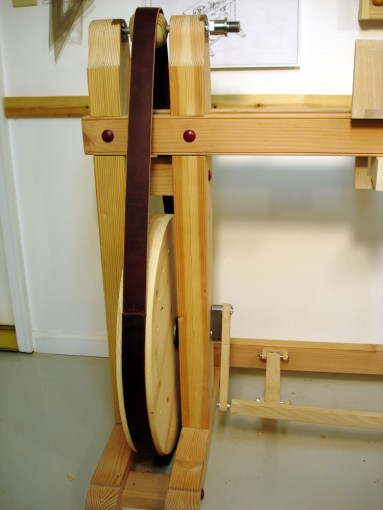My first “up close and personal” acquaintance with a steam traction engine was several(?) decades ago at an Antique Tractor show in Portland Indiana. More recently, I watched a 1913 Case engine drive a threshing machine at the Dakota County (Minnesota) fair late this summer. When these engines drive threshing machines or saw mills, power transfer is by use of a very wide and tremendously long fabric belts. I once asked an engine operator about how taut to make the belt. He advised, “only taut enough to keep it from slipping. Any tighter stresses axles and bearings.” The following video (not mine) shows an engine driving a threshing machine.
 Wander around and look at shopmade wooden treadle lathes. You’ll find all manner of drive “belts.” Many use rope or leather cords. In doing my research, I saw a lot of lathes where the builder used extra idlers to add tension, usually to cords or ropes. Those look like very fussy contraptions.
Wander around and look at shopmade wooden treadle lathes. You’ll find all manner of drive “belts.” Many use rope or leather cords. In doing my research, I saw a lot of lathes where the builder used extra idlers to add tension, usually to cords or ropes. Those look like very fussy contraptions.
Instead of using a narrow cord or rope, I decided to model my drive after the traction engines, with a wide leather belt. My intent was to eliminate the need for a fussy tension idler and to keep tautness to something less than a gnat’s ass stretched over a rain barrel. My drive belt is 2″ wide material from Tandy. The longest belting strips they offer are 72″ long. It takes the better part of two lengths to make this belt.
I made it long enough to be a snug, but not particularly taut, fit over the flywheel and temporary spindle pulley. It doesn’t slip, and the rounded shape of the spindle pulley sure keeps it on track.
Looks like it’s ready to make something Bob. Have you decided on the first piece yet?
Almost Ralph,
Still need to complete the tool rest.
The first real turning will be a replacement for that ball pulley on the spindle.
BTW, good to see you getting lots of shop time lately. I imagine your daughter is very pleased with the wine table.
Bob, We used to run some belt drive equipment off of our tractors. The long flat belts depend on gravity as much as anything to keep them tight. you can pull them off without moveing the tractor or the machine. the belts were always put away when not in use. Good luck with the lathe!
Mike
Bob, that is a great idea on the Tandy belts for the drive. In the picture there are little red dome shaped something, are those plugs over bolts or pins through the assembly?
Cheers,
Jeremy
Thanks for that Mike! Makes sense, especially for the size of those belts.
Jeremy, the red spots are the head ends of zinc coated carriage bolts that have been painted red to make them less ugly.
There’s probably no good way to quantify the amount of tension on the belt, but out of curiosity, I wonder how much deflection you get pushing in the belt (at the midpoint between the drive wheel and flywheel) just pushing it with your index finger? That might help get us who are yet to build in the right ballpark at least.
Hello Ryan,
The belt actually feels a bit slack. Yet, a moderate push at the midpoint yields only about an inch. You’ll likely find that you have to “sneak up” on the correct belt tension. I did. When the belt tends to slip too easily, ease it off of the flywheel, cut the bindings and about an 1/8-1/4″ off of one end and rebind. It takes only about 10 minutes and once right seems to hold for a very long time.
I thought that a lot easier than building extra tension arms and springs and such.
Have fun building one!
How did you join the two leather belts??
Hello Zeke,
The belt ends are sewn together. I used a heavy upholstery thread. I punched holes in the leather with an awl, and stitched over-n-under 8 stitches wide. Each of the 8 has 3 passes of thread.
Build one when you can. You’ll have a great time with it.